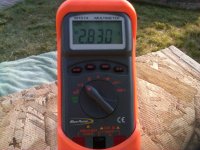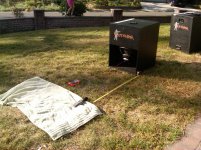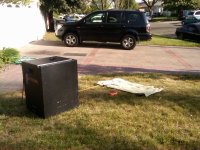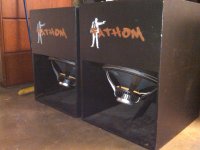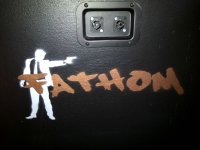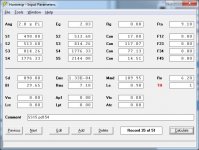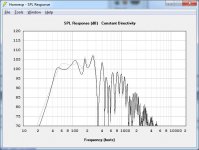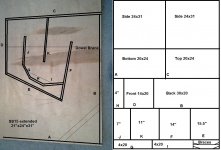What can all you pro builders tell a newb. Cabinets are finished kind of. I need to know what the "proper" way to complete them. Is a Speakon better than a 1/4" and which is most widely used? When using either how do you tell polarity? Anybody have a preferred terminal box?
"Pro builder" response..
Speakons are the way to go
A) jacks can short an amp if pulled out / pushed in when powered on
b) jacks can easily be pulled out, speakons lock into position
c) speakons are air tight, so no whistling / loss of pressure through the back of your cabinet
d) speakons have tiny little "+" and "-" signs to show which is which
e) aside from some older style bass and electric guitar cabinets, jacks are only found on the cheapest pro audio cabinets - just take a look at the rear views of cabinets in various price ranges.
Regards, Ben
Speakons are the way to go
A) jacks can short an amp if pulled out / pushed in when powered on
b) jacks can easily be pulled out, speakons lock into position
c) speakons are air tight, so no whistling / loss of pressure through the back of your cabinet
d) speakons have tiny little "+" and "-" signs to show which is which
e) aside from some older style bass and electric guitar cabinets, jacks are only found on the cheapest pro audio cabinets - just take a look at the rear views of cabinets in various price ranges.
Regards, Ben
What can all you pro builders tell a newb. Cabinets are finished kind of. I need to know what the "proper" way to complete them. Is a Speakon better than a 1/4" and which is most widely used? When using either how do you tell polarity? Anybody have a preferred terminal box?
Polarity is simple.
Get a battery and positive to the positive terminal will push the cone out. You have to jumper the battery positive to positive and negative to negative. Reverse should do the same.
Don't do it for an extended period of time but short bursts will cause no harm at all.
Get a battery and positive to the positive terminal will push the cone out. You have to jumper the battery positive to positive and negative to negative. Reverse should do the same.
Don't do it for an extended period of time but short bursts will cause no harm at all.
LOL
No forklift battery!
How about a 1.5 volt of your choice, AA or AAA
you can use a nine volt but your applying a few watts DC over the coil. not what you really want to do. 1.5 volts is safe enough to use on almost everything.
Not compression drivers.
Mark
No forklift battery!
How about a 1.5 volt of your choice, AA or AAA
you can use a nine volt but your applying a few watts DC over the coil. not what you really want to do. 1.5 volts is safe enough to use on almost everything.
Not compression drivers.
Mark
isn't polarity reversed in a th :?
you'd probaply need to mach it up with the rest of the system.
i would advise to use the speakons with a recesplate.
you'd probaply need to mach it up with the rest of the system.
i would advise to use the speakons with a recesplate.
I made that mistake (seemed logical at the time), now I have to reverse the banana plug on my amps :^(.actaly,the cone is loaded on both sides.
but i would say + on the black/mines terminal.
The primary "heavy lifting" in a tapped horn is done by the long horn path, connecting the speaker so that positive voltage results in the cone pushing in to the horn (+ to the red terminal on most speakers) then compensating for the path length error (delaying the top cabinet) will result in a smooth phase transition.
The horn path length on the SS15 is about right so that if the speaker is hooked up + to + it will be about one wavelength behind a front loaded cabinet with a crossover around 80-100 Hz, so will also result in an "in phase" (but lagging) transition with no compensating delay.
That said, what we hear first sounds louder, without delay the bass will not seem as loud as the top cabinet, and won't have the definition or "punch" that proper time alignment provides.
Art
So Art what way would you say is the best polarity? Also what is the prefered way to attach the leads to the sub? Rings, solder or some other I am not thinking of?
To repeat #1489, connecting the speaker so that positive voltage results in the cone pushing in to the horn (+ to the red terminal on most speakers) then compensating for the path length error (delaying the top cabinet) will result in a smooth phase transition to the top cabinet.So Art what way would you say is the best polarity? Also what is the prefered way to attach the leads to the sub? Rings, solder or some other I am not thinking of?
"Most speakers" was mentioned because many older JBL speakers are wired so positive voltage to the red terminal makes the cone go toward the magnet structure, opposite from today's "normal" convention.
Connecting the leads can be done mechanically, as in the screw terminals used in most Speakon connectors, or with solder, as is used on connectors like the Cannon EP-6.
Some speakers use push terminals, wire is simply put in the terminal. If the speaker has spade terminals, spade lugs can be crimped or soldered on, or wire can be directly soldered to the terminal.
I prefer a good solder connection which precludes oxidation and bi-metallic corrosion, others prefer mechanical connections. That said, if the speaker has a push terminal, I use it, if not I solder it.
Art
Built these last year - did some testing today:
Enclosure: SS15
Construction: 1/2" Aurauco
Designer: jbell
Driver: Eminence 3015LF
Amp: QSC PLX3402
Volt-Ohm Meter: Blue-Point MT574
SPL Meter: American Recorder Technologies SPL-8810
*Settings:
-Weighting: C
-Time weighting: Fast
-Sound level: Hi = 60-130dB
Conditions: ground plane, outdoors, over grass
The following measurements were done at 1W/1M (3.3 feet or 3'4"). The driver tested is published as 8 ohms from the manufacturer. Amplifier voltage of 2.83v was measured at the driver's terminals.
*Please remember, C-weighting has NOT been accounted for/factored in and the appropriate amount of dB need to be added to these measurements to compensate. I only have an image of the graph/curve without exact numbers to calculate with.
30Hz: 81.1
35Hz: 85.8
40Hz: 90.7
45Hz: 94.2
50Hz: 98.6
55Hz: 101.4
60Hz: 101.7
65Hz: 102.7
70Hz: 103.2
75Hz: 102.1
80Hz: 101.8
I do not have 85Hz, 95Hz or 105-120Hz and found 90Hz & 100Hz on my computer later in the evening.
But, I tested some tones with a bit of power (just at clip) to factor in power compression. Had the SPL meter on peak hold. Amp is rated at 700W/ch @ 8 ohms. Here's what we measured at 1 meter (the same conditions stated at the top):
121.9dB @ 50Hz
123.5dB @ 55Hz
124.7dB @ 70Hz
I played a single track for program material and turned it up again for the same reasons above.
122.1dB w/(1) SS15
124.5dB w/(2) SS15 wired parallel on one channel (~550W/cab), standing side by side
This is how we normally run the pair while another pair is driven on the other channel.
All tests were with the cabs standing up.
Below I've attached a photo of the drive voltage used, measurement conditions (mic not centered during photo and 2nd SS15 was not there during tests) and couple post-build photos.
Cheers!
Enclosure: SS15
Construction: 1/2" Aurauco
Designer: jbell
Driver: Eminence 3015LF
Amp: QSC PLX3402
Volt-Ohm Meter: Blue-Point MT574
SPL Meter: American Recorder Technologies SPL-8810
*Settings:
-Weighting: C
-Time weighting: Fast
-Sound level: Hi = 60-130dB
Conditions: ground plane, outdoors, over grass
The following measurements were done at 1W/1M (3.3 feet or 3'4"). The driver tested is published as 8 ohms from the manufacturer. Amplifier voltage of 2.83v was measured at the driver's terminals.
*Please remember, C-weighting has NOT been accounted for/factored in and the appropriate amount of dB need to be added to these measurements to compensate. I only have an image of the graph/curve without exact numbers to calculate with.
30Hz: 81.1
35Hz: 85.8
40Hz: 90.7
45Hz: 94.2
50Hz: 98.6
55Hz: 101.4
60Hz: 101.7
65Hz: 102.7
70Hz: 103.2
75Hz: 102.1
80Hz: 101.8
I do not have 85Hz, 95Hz or 105-120Hz and found 90Hz & 100Hz on my computer later in the evening.
But, I tested some tones with a bit of power (just at clip) to factor in power compression. Had the SPL meter on peak hold. Amp is rated at 700W/ch @ 8 ohms. Here's what we measured at 1 meter (the same conditions stated at the top):
121.9dB @ 50Hz
123.5dB @ 55Hz
124.7dB @ 70Hz
I played a single track for program material and turned it up again for the same reasons above.
122.1dB w/(1) SS15
124.5dB w/(2) SS15 wired parallel on one channel (~550W/cab), standing side by side
This is how we normally run the pair while another pair is driven on the other channel.
All tests were with the cabs standing up.
Below I've attached a photo of the drive voltage used, measurement conditions (mic not centered during photo and 2nd SS15 was not there during tests) and couple post-build photos.
Cheers!
Attachments
Last edited:
Hi!
Your measurements are quite within I found here; excellent SPL at 1W/1M; but at the limit severe power compression, I think due to the cone control which is absent when real power comes in, even with good 18Sound drivers.
So contacted Jbell in respect of restricting the throat a la furybox (letter box).
He suggested a round restriction which I made attaching it inside (two"C" form glued together), to equal the pressure to all the cone.
Actually the cone control is far better and despite no measurement after it, with the B&C 15CL76 it appatently goes a bit lower...
Pictures of it were published in this tread before.
Regards,
Your measurements are quite within I found here; excellent SPL at 1W/1M; but at the limit severe power compression, I think due to the cone control which is absent when real power comes in, even with good 18Sound drivers.
So contacted Jbell in respect of restricting the throat a la furybox (letter box).
He suggested a round restriction which I made attaching it inside (two"C" form glued together), to equal the pressure to all the cone.
Actually the cone control is far better and despite no measurement after it, with the B&C 15CL76 it appatently goes a bit lower...
Pictures of it were published in this tread before.
Regards,
He suggested a round restriction which I made attaching it inside (two"C" form glued together), to equal the pressure to all the cone.
What should the ID (inner diameter) of the circle be?
pd154 in ss15
Hi Sjpaul,
According to Hornresp, the PD154 will work, but they are a bit peakier with more below 55hz and less from there to 90 compared to the 3015lf.
Attached are some hornresp files to get you playing - the plot shows the pd driver in black vs the 3015lf in grey (both at 2.83v), but keep in mind the re of the pd is 6.2 ohms vs 5.3 for the 3015, so the power used for the pd would be less for that graph. To get the same power input, enter 3.06v for the pd which is 2.83x(sqrt(6.2/5.3)).
Have a play with hornresp and see how you go.
Is forum member Dave NonZero anywhere near you in Scotland? I think he has built a whole pile of boxes including some ss15s...
cheers,
Richard
Hi Sjpaul,
According to Hornresp, the PD154 will work, but they are a bit peakier with more below 55hz and less from there to 90 compared to the 3015lf.
Attached are some hornresp files to get you playing - the plot shows the pd driver in black vs the 3015lf in grey (both at 2.83v), but keep in mind the re of the pd is 6.2 ohms vs 5.3 for the 3015, so the power used for the pd would be less for that graph. To get the same power input, enter 3.06v for the pd which is 2.83x(sqrt(6.2/5.3)).
Have a play with hornresp and see how you go.
Is forum member Dave NonZero anywhere near you in Scotland? I think he has built a whole pile of boxes including some ss15s...
cheers,
Richard
Hi all,
New here, so I have way less experience in the design and build side of things but have been looking for a project to use a pair of Precision Devices PD154 drivers that are awaiting reconing...
Does anyone have an opinion on the suitability of these drivers for the single sheet 15 box?
Here are the T/S parameters:
Fs 39Hz
Re 6.2 ohms
Qts 0.205
Qms 4.32
Qes 0.216
Vas 149 litres
Mms 125 grams
Sd 890 cm^2
Cms 133uM/N
Bl 29.65 T/m
Xmax 7.7mm
Vd 0.658 litres
Ref efficiency 3.94%
Thanks in advance....
Steven.
Attachments
ss15extended
Ok, so my friend DJIM gently got me to act on this.... I haven't touched the ss15 design in months -- it just works so well.
The only downside for me, is that it is not a 'flat to 40' box. And I'm big on flat to 40.
So, a bit of 'S2 cone correction' instead of a compression plate.
1" taller and 1" narrower...
and the SS15 can now hit with authority an honest to goodness 40hz.
This is still on paper and hornresp only, and it'll be a week or so before I can build/test... But I do have assembled 'original' SS15 cabinets, and I can do an A-->B comparison.
It "should" eliminate the one glaring weakness I see in the ss15. And it still does it from a single sheet, but this time you really do have nothing but sawdust left over... You even have to use the driver disk cut out from the baffle board as bracing.
Ok, so my friend DJIM gently got me to act on this.... I haven't touched the ss15 design in months -- it just works so well.
The only downside for me, is that it is not a 'flat to 40' box. And I'm big on flat to 40.
So, a bit of 'S2 cone correction' instead of a compression plate.
1" taller and 1" narrower...
and the SS15 can now hit with authority an honest to goodness 40hz.
This is still on paper and hornresp only, and it'll be a week or so before I can build/test... But I do have assembled 'original' SS15 cabinets, and I can do an A-->B comparison.
It "should" eliminate the one glaring weakness I see in the ss15. And it still does it from a single sheet, but this time you really do have nothing but sawdust left over... You even have to use the driver disk cut out from the baffle board as bracing.
Attachments
Last edited:
That's the spirit!😀...it still does it from a single sheet, but this time you really do have nothing but sawdust left over... You even have to use the driver disk cut out from the baffle board as bracing.
Which driver are you going to use in this one?
Is there a 'best' driver for this box?
- Home
- Loudspeakers
- Subwoofers
- Single sheet TH challenge
